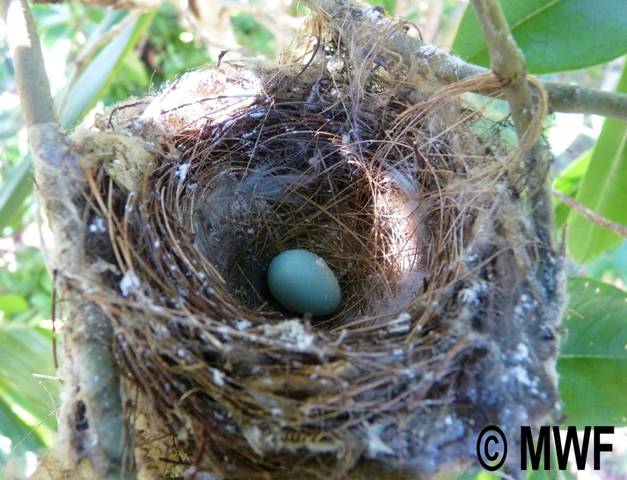
Pair of Olive White-eye
|
| |

Olive White-eye egg in nest
|
| |
 Olive White-eye chick in nest Olive White-eye chick in nest
|
| |

Working with Olive White-eye
|
| |
|
The Mauritius Olive White-eye is the smallest of the Mauritian songbirds and is the least known of all the Mauritian birds. It is only found in the upland forest of the Black River Gorges National Park and is considered as Critically Endangered by IUCN due to the severe decline in population size and distribution over the past 30 years. The current population is estimated at only 100-150 pairs.
In 2005 the Mauritian Olive White-eye Recovery Project was initiated to help save the species from extinction. A field team was based at Combo (the site of the wild population) to study the birds and increase our knowledge of their breeding and general behaviour. Following this, attempts were made to bring chicks into captivity for hand rearing at the Gerald Durrell Endemic Wildlife Sanctuary to avoid predation by rats, birds and monkeys. Following the successful hand rearing of four fledglings intensive management was initiated.
The aim of the project (modelled on the successful Mauritian Fody Project) was to rescue as many nests as possible from the wild population at egg stage and hand rear chicks for release onto the offshore island of Ile aux Aigrettes (a nature reserve free from mammalian predators).
Between 2005 and 2010 a total of 38 Olive White-eyes were released onto Ile aux Aigrettes. The first breeding attempts were seen in 2007 with the first eggs laid and chicks hatched and the first fledglings were seen in 2008. In 2009 a record amount of birds fledged with 14 birds fledging from 5 breeding pairs. Successful nesting was seen for the following season and the total population on Ile aux Aigrettes is currently 25. Our research on the island aims to understand more about this rare species and to identify the pressures facing them and the limiting factors on populations.
Work on the Olive White-eye project is now focused on intensively monitoring the breeding activity of both the released and wild populations to learn more about productivity. In the wild population we have been examining whether rat control by poison increases nesting success. As this seems to be the case, it may be implemented in the Combo population in order to boost wild numbers whilst the Ile aux Aigrettes population is still developing. Nest rescues will be discontinued, due to the success of nesting on the island but both populations will continue to be extensively monitored and the data collected will be analysed to further our knowledge and assist in the long-term management of the species.
|
|